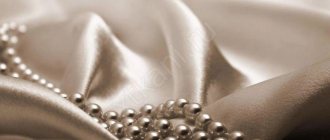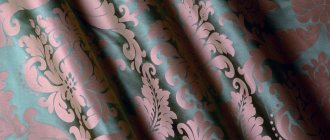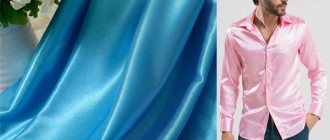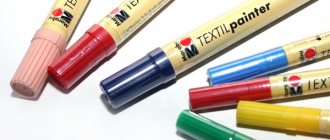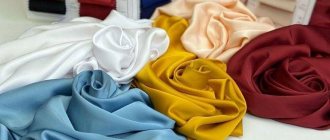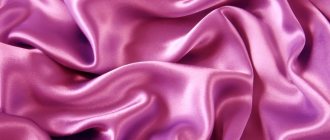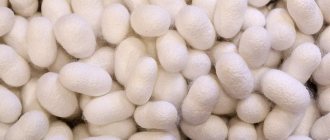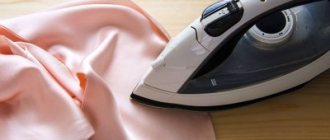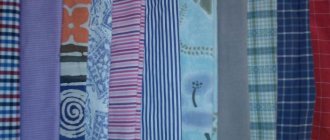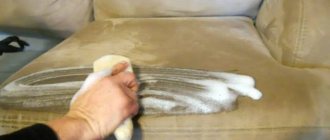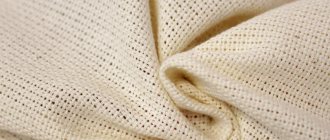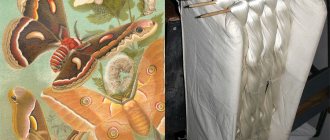Description and production
For a long time, silk fabrics were produced only from threads produced by the silkworm, but all this until it became clear that a similar cocoon was also woven by butterflies from another family - the peacock-eye (oak silkworm). They learned to cultivate the oak silkworm only 250 years ago, so this material, in the old fashioned way, is usually called wild silk (dupion). However, even now the cultivation process is problematic and not always justified, therefore, to produce fabric, the silk of the oak silkworm is simply fed in the wild. If we talk about what fabrics chesucha belongs to, then these are, of course, wild silks. You can see what wild silk fabric looks like in the photo.
To understand what kind of comb fabric it is, it’s worth talking about its production, especially since this process is quite interesting.
- The fibers are combed from the cocoon and carefully sorted
- Then the whole mass is tousled and impurities are removed.
- Soak and dry thoroughly
- Comb out again and form thin tufts.
- They are twisted into threads and woven using the plain weave method. What it is? This is a weaving technique where the warp thread is much finer than the weft thread.
As a result, we get a material that can be described as follows: texture, rough surface and density are much higher than other silks. Let's see what chesucha fabric looks like - photos of the fabric and products made from it.
How to care
Chesucha requires delicate care:
- Hand wash is allowed at 30 degrees, but dry cleaning is preferable;
- gentle detergents are used for washing;
- rinse in cool water;
- cannot be pressed;
- iron from the wrong side and only after complete drying;
- do not dry in the sun.
Advice! Add a little vinegar to the rinse water to refresh the color.
Chesucha is a fabric for fans of natural textiles. It is environmentally friendly and hypoallergenic. Shantung is often sold in a pleasant honey-golden color, without dyeing. It looks interesting and impressive.
China became the first country to produce shantung or otherwise chesucha. People call the material wild silk, since the cocoons from which this silk is made are woven by oak silkworms. Oak silkworms are very difficult to breed at home, so the raw materials are collected in the wild. The fabric is produced using the linen weaving method. Shantung has a golden sheen and a rough surface due to the threads. The threads have different lengths and heterogeneity. It has a creamy or sandy natural color, very rarely with an olive tint. A variety of printed images, embroideries, etc. look very impressive on shantung. Chesucha is a more affordable fabric than classic silk. In our online store you can choose any material you like.
Qualities of silk shantung
The disadvantages include that the fabric wrinkles very easily, deteriorates in the sun, and without proper care the fabric will easily deteriorate. Where is shantung used? Bed linen and other home textiles are sewn from shantung. The fabric is excellent for clothing, in particular for sewing: pants, suits, raincoats, dresses, blouses, shirts, skirts. Great for people who love naturalness. Fabric care It is recommended to wash shantung at a temperature of no more than 30 degrees, using gentle detergents, rinse exclusively in cold water, and never wring it out or hang it in the sun.
Our online store sells fabrics at retail and wholesale. If you have any questions, you can contact the manager by phone number.
The silk of oak silkworms has a number of positive aspects:
- the fabric is hypoallergenic and pleasant to the body;
- allows air to pass through;
- dense and drapes well;
- has excellent texture;
- thermally conductive;
- solvent resistance;
A lot of interesting things can be said about the heroine of our article today. Chesucha - what kind of fabric this is, few people know, but, meanwhile, it is also natural silk, albeit wild.
Compound
Secretions of the glands of the oak silkworm. In other matters, modern techniques make it possible to add cotton fibers to the material. What can I say, if you decide to buy this material today, you will most likely come across a material that contains only cotton or cotton and viscose. Carded cotton fabric - what is it? This is a material that only imitates silk, of course, it is cheaper. The Trekhgorka comb cotton fabric (produced by Trekhgornaya Manufactory) is especially popular. Price per linear meter of material - from 270 rubles (imitation) and from 1200 rubles (dupion)
Fabrics with a silk surface are the embodiment of elegance and luxury
The fabrics from this section are similar to each other, have plain weaving threads and the same characteristics. The catalog pages of our online store present beautiful fabrics, a relative of which is natural silk:
- chesucha is a material made from combed and partially unwound oak silkworm fibers. The raw material goes through many stages, including sorting, removing impurities, soaking, drying, etc. Chesuchu is also called shantung after the province in China where such fabric was first produced. Natural fabric has healing properties and has a beautiful texture;
- taffeta is a thin, pleasant-to-touch fabric made from cotton, silk or synthetic threads. This material was popular in Rus', where it came from Byzantium, but Persia is considered to be its homeland. Taffeta is valued for its density and versatility, due to which it is used for sewing not only clothes, but also curtains, furniture upholstery, etc.;
- muslin is a light, airy material that is worth buying to create summer outfits. It can be used as an alternative to taffeta for sewing curtains, bed linen, blouses, evening dresses, and shirts. You won't feel hot in muslin outfits, as they are breathable.
Taffeta and other fabrics with a silky surface, made from natural fibers, absorb moisture well and dry quickly. Wear-resistant products with a noble shine will decorate your wardrobe. In the catalog we have collected taffeta, muslin, muslin from reliable Italian manufacturers. You can purchase wholesale and retail plain, iridescent, patterned fabric, as well as fabrics with embroidery and lurex.
Properties
What is comb silk if not a natural material, which means it is characterized by many positive qualities:
- High density (other silk fabrics have much lower density)
- Strength
- Specific textured surface
- Strength and resistance to mechanical damage and abrasion
- Good breathability and hygroscopicity, characteristic of all natural materials
- Excellent thermal conductivity, which provides comfort in both cold and hot weather
- Hypoallergenic
The disadvantages include the following properties:
- The product may deteriorate if exposed to direct sunlight.
- Items made from this material require careful care
- They also wrinkle a lot
Notes[ | ]
- Ozhegov S. Yu.
Explanatory dictionary of the Russian language. - M., 1992. - P. 926. - ↑ 12
Silk / G. N. Kukin // Great Soviet Encyclopedia: [in 30 volumes] / ch. ed. A. M. Prokhorov. — 3rd ed. - M.: Soviet Encyclopedia, 1969-1978. - ↑ 1 2 Bazhenov V.I.
Materials for garments. — 1982. - ↑ 1 2 Maltseva E. V.
Materials science of clothing production. — 1986. - Smirnov P.
Silk is being taken away from the Chinese
(undefined)
(inaccessible link). Gazeta.ru (May 26, 2008). Access date: July 8, 2008. Archived May 29, 2008.
Care
Maintenance, as we said, is not the easiest. Read the product label carefully, and we will give here only general rules:
- If heavily soiled, take the item to dry cleaning
- Hand washable in 30 degree water
- You should not use washing powder, it is better to add baby soap to the water
- Rinse with water and vinegar
- There is no need to wring out the items in the machine or twist things out of the scallop with your hands - let the water drain on its own
- Dry naturally on a flat surface
- Iron with an iron set to “Silk” mode.
What they sew, application
Festive clothes are made from chesucha. These can be dresses, shirts, overalls - they all look rich and have a characteristic matte shine. And also from some types of chesuchi they sew everyday things.
In addition to clothing, household items are made from fabric: curtains, napkins, tablecloths. In luxury homes you can even find furniture covered in cardboard: armchairs, sofas, etc.
Reviews
Natalya, 47 years old: My youngest daughter is a very original girl, she always wants something unusual. And when it came to choosing the material for the prom dress, she wanted chesucha. I gave in and was convinced that the choice was justified - the dress looks so unusual - with a textured surface, shine and an unusual but natural shade. In addition to the lyrics, in a dress made of this material, her daughter, according to her, felt comfortable - not hot in a stuffy room and not cold on a morning walk. Still, it’s a natural material.
Irina, 34 years old: I remember my dad was very fond of scalloped shirts. He wore them both on holidays and every day. I really liked the feel of this material - so unusual, textured. I bought this shirt for my husband, but after touching the fabric, I realized that something was wrong. As it turned out in the end, comb items are now made from cotton, but they only look like real dupion from afar.
Additionally:
- How silk and its types are made;
- Brushed footer - does it shrink when washed?
- Polyviscose - natural or not?;
Characteristic
Chesucha is a dense fabric. Chesuchovy
The material has a plain weave. Thickening and uneven surface are the main features by which this fabric can be distinguished from similar options. Its standard width ranges from 74 to 91 cm. It is not only attractive in appearance, but also very dense. But this does not prevent it from being pleasant to the body and having a wide range of applications.
Advantages:
- Dense;
- Has an interesting texture;
- Inexpensive compared to “standard” silk;
- Durable and wear-resistant;
- Wide scope of application;
- Clothing made from this material creates a comfortable temperature at any time of the year;
- Pleasant matte shine;
- Hygroscopicity;
- Hygiene;
- High degree of absorption;
- Does not cause irritation or allergies;
- Draps well;
- Tensile strength;
- Does not become wet, even if it absorbs 30% of moisture in relation to its own weight;
- Does not lose shine over time;
- High degree of resistance to organic solvents. Only highly concentrated solutions of alkalis and acids can negatively affect it.
Flaws:
- Requires delicate care;
- Water stains and stains may occur;
- With constant contact with sweat, the fabric can become brittle and lose its original characteristics;
- Depending on production, medium or high degree of creasing;
- Low light fastness. From constant exposure to direct sunlight, the fabric loses its strength (only 200 hours of open sun is enough to reduce the characteristics by 2 times)
It is also necessary to add one “neutral” quality. Wild silk has a medium degree of heat resistance. It can withstand short-term exposure to high temperatures, but frequent abuse causes the material to become very brittle.
